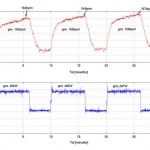This article is incomplete, pending approval from team trainers, and input from several other team members.
 All cycling trainers stress the importance of doing intervals. This article will discuss the what, how and the why of interval training as it applies to Masters.
All cycling trainers stress the importance of doing intervals. This article will discuss the what, how and the why of interval training as it applies to Masters.
What are Intervals?
From bikingtolive.com:
“In cycling we use the word ‘Intervals’ to define short periods of time (30 seconds to several minutes) over the course of a ride. For instance, you might hear a cyclist say that he or she performed three eight minute intervals during the workout today. That means that they broke out 24 minutes (3×8=24) as measured periods of time from their overall ride duration.”
Why do Intervals?
Some reasons aren’t as obvious as others, but here is a short list:
Reason 1: To Put More Effort in to a Shorter Workout. You don’t always have time to go out and ride for hours and hours. You can use more effort in an hour ride by placing intervals in the ride plan. This way you can burn more calories in less time, which leads to:
Reason 2: To Lose More Weight. Intervals consume more calories than Zone 1 or 2 1 riding, hence they are a way to burn calories in less time. Losing weight is a great way to improve performance as “Weight is Freight”, which leads to:
Reason 3: To Increase Your Performance. A cyclist is limited by Lactic Threshold (LT); defined as that amount of effort where the body can remove the lactic acid built up in the muscles at the same rate it is produced. Any attempt to exceed this threshold will result in pain and increased heart rate, as the body tries to keep up. Exceeding LT in intervals “trains” the body to remove lactic acid faster, increases heart rate, and also increases circulation, thereby raising LT in the future. Higher LT means more performance.
From thesportfactory.com:
“Increasing lactate threshold is one key goal of training for athletes racing in events lasting from thirty minutes to five hours. Raising lactate threshold enables an athlete to race more effectively at intensities significantly below lactate threshold, near lactate threshold, and above lactate threshold.”
How Should I Do Intervals?
If you have a coach or trainer, please follow their instructions for you. We can only advise what works for us. With that in mind, below are a few suggestions from our athletes on the race team:
Bill Edgbert
“Older adults should use HIT (High Intensity Training) sessions to perform interval training as opposed to TET (Traditional Endurance Training). HIT sessions consist of efforts at 85% to 90% of MHR (Maximum Heart Rate) varying in length from 30 to 60 seconds to as long as 3 to 5 minutes followed by resting intervals sufficient in length to achieve 40% to 50% MHR for 1 to 2 minutes. Power can also be used where the hard intervals will be done at FTP (Functional Threshold Power) or slightly above and the rest intervals done at Recovery to endurance power levels. These intervals are repeated for a duration of 30 to 60 minutes depending upon the fitness of the individual followed by a 10 to 20 minute maximum cool down period down at recovery heart rate or power level. After the workout avoid eating for at least 30 minutes. Use this time for stretching or relaxing and not to increase heart rate during the immediate recovery period. This immediate recovery period is critical for producing the expected result i.e. production of certain hormones and enzymes to condition your body and increase your fitness and endurance level. The longer term recovery period should be at least 24 hours before taking on another HIT session. Recovery is the most critical ingredient to interval training. Without proper recovery you will just wear yourself done and not gain fitness and endurance. More could be discussed as to why older adults should use this approach and all the physiological events that take place during and after a HIT session. For that you may want to look at this article”
John Tenney
“I have found that shorter intervals are easier to do mentally. I was initially told to do 3×10 minute intervals at ‘all out pace.’ I found that I was not really going all out because mentally I was ‘saving’ some for the end of the interval. When I changed to 3×5 minute intervals I expended much more effort and felt like I was getting the same intensity training.”